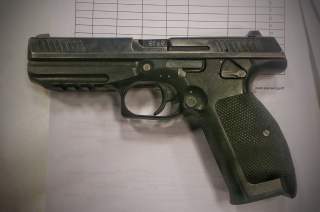Russia's New PL-15 Pistol: Better Than a Glock Gun?
Take a look and decide.
It was tested and evaluated, but many (including firearms expert Vladimir Onokoy) found the double-action trigger to have too long of a reset for proper rapid fire. Otherwise, the ergonomics and handling of the pistol were found to be excellent.
The PL-15 is hyped up by Kalashnikov Concern to be one of the best pistols in the world. Said to be light, accurate, and soft-shooting, Kalashnikov Concern plans to start producing the gun in 2019. However, the Russian military has not yet expressed official interest in procuring the gun. But should they? Does the PL-15 represent a large step up from existing sidearms?
The short answer is, yes. The Russian military still predominantly uses the 9x18mm Makarov pistol, a single stack design from the 1950s. The PL-15 represents a quantum leap ahead of this ancient design, being a modern, striker-fired pistol. However, the Makarov is likely to soldier on for much longer in wide service.
(This first appeared earlier in June 2019.)
The story of the PL-15 begins in 2014, when Dmitri Lebedev, the pistol’s namesake and primary designer, was recruited by Kalashnikov Concern to work on a new pistol. Lebedev had worked in small arms for many years prior, being an armorer and competitor for various Russian competition shooting teams.
He began work in a new pistol, called the PL-14 that would amalgamate the features of most successful foreign pistols into a domestic design. The pistol featured a low bore axis and long beavertail similar to Glock, Steyr M, and Caracal pistols, an internal double-action trigger similar to the original FN Five-seven, and low profile recessed controls suitable for duty use.
It was tested and evaluated, but many (including firearms expert Vladimir Onokoy) found the double-action trigger to have too long of a reset for proper rapid fire. Otherwise, the ergonomics and handling of the pistol were found to be excellent.
Lebedev took the pistol back to the drawing board and redesigned it as the PL-15, a revised version that incorporates a striker trigger for a fast, short reset. Interestingly, unlike the Glock and most of its imitators, the PL-15’s trigger does not feature a trigger safety, instead opting for a manual safety on the side of the gun. This is a rather uncommon configuration, although the US military’s M17 uses it as well. The PL-15 also uses an aluminum alloy frame in contrast to the Glock and most other modern service polymer pistols.
By most accounts, the new PL-15 and PL-15K is an excellent pistol. So why is it unlikely that it will replace the Makarov?
As with most new equipment, the PL-15 is likely to go first to very special units in the army. These units largely use Glock pistols imported and assembled at Izhmash. Replacing the Glocks with a Russian pistol likely will be used for great propaganda value.
Those not fortunate enough to get Glocks largely use the MP-443 or PYa pistol. A troubled design that was arguably outdated the moment it was introduced into service, the PYa was Russia’s first serious attempt at a modern 9x19mm pistol. However, the design was brought down by low reliability, low service life, and the simple fact of being a heavy, full steel single-action/double-action pistol in an age of polymer striker service pistols.
Though most of these kinks have been worked out and the PYa is a common sight in the holsters of special troops nowadays, PL-15s are likely to replace the PYa’s next, as most PYa users actually use their pistols in training and the line of duty and would benefit from a newer, better pistol. The PL-15 learned many lessons from the PYa’s troubled development: it was extensively tested, built to last (no less than 10,000 rounds of very hot ammo), and was designed with an aluminum frame to reduce weight.
But the majority of pistol users in the Russian military rarely use their pistols. Replacing Makarovs across the entire army would be a costly endeavor for a minimal increase in combat effectiveness. If the PL-15 is wildly successful it might be bought in small numbers to replace worn out Makarovs, but it seems that the Russian military is taking a skeptical approach towards new pistols after the PYa debacle. The Makarov will soldier on.
Charlie Gao studied political and computer science at Grinnell College and is a frequent commentator on defense and national security issues.
Image: The Firearm Blog.

